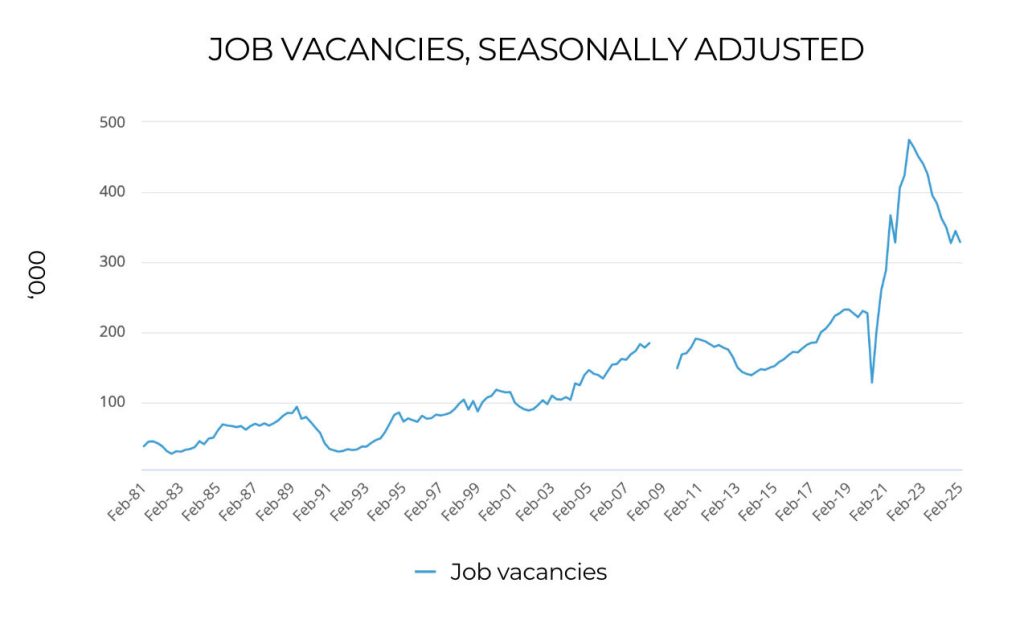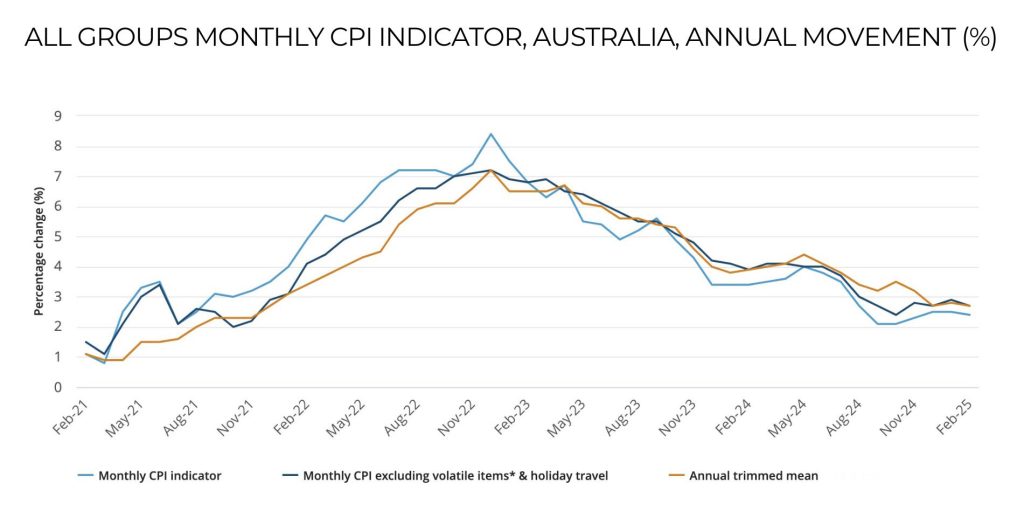Rateseeker Round-up: April Business News

As we head deeper into 2025, Australia’s business and property sectors show a mix of steady resilience and subtle change.
Inflation has finally eased back into the Reserve Bank’s target range, offering some welcome relief to households and raising hopes for a softer interest rate environment ahead. At the same time, job vacancies continue to decline, signalling a slight cooling in the labour market. However, worker demand is still well above pre-pandemic levels, keeping recruitment competitive.
Construction activity, while dipping slightly, remains historically strong. Over 800 cranes are still operating across the country, with Sydney and Melbourne leading the charge. This points to a steady stream of ongoing development, despite cost pressures in the building industry.
Meanwhile, most businesses, large and small, are holding their ground. Profit margins are tracking close to long-term averages, and many have adapted to higher operating costs through cost-cutting, revenue growth, or a bit of both. Balance sheets remain strong, giving businesses the resilience they need to weather future uncertainty.
In this month’s update, we explore what this means in practical terms, whether you are planning to hire, build, invest, or simply make sense of where the economy is heading next.
Job Vacancies Easing, But Labour Market Still Tight
According to the latest data from the Australian Bureau of Statistics (ABS), job vacancies have declined in 10 of the past 11 quarters, a clear sign that the red-hot labour market is starting to cool.
Vacancies peaked at an all-time high of 474,700 in May 2022 but have since fallen to 328,900 as of February 2025. That’s a 30.7 per cent drop over the past two and a half years.

However, while opportunities have scaled back, the worker demand remains elevated. ABS Head of Labour Statistics Sean Crick noted that job vacancies are still 44.5 per cent higher than before the COVID-19 pandemic began in 2020.
The December quarter continues to show strong demand for people, with vacancies still tracking at around 2.1 per cent of all jobs in Australia. This was unchanged from the previous quarter and higher than the pre-pandemic rate of 1.6 per cent.
Sean Crick – ABS Head of Labour Statistics
In short, while recruitment has become a little easier than during the peak of the labour shortage, it is still competitive. Attracting and retaining top talent remains challenging, especially for small and medium businesses.
If you’re hiring now, here are five ways to improve your chances of finding the right people:
- Write clear and engaging job ads that speak directly to your ideal candidate.
- Offer competitive salaries and attractive benefits to stand out from the crowd.
- Be transparent, listing a salary range builds trust and attracts serious applicants.
- Move quickly, strong candidates are often snapped up in a matter of days.
- Be flexible, offer remote options, or consider hybrid schedules to widen your talent pool.
A tight labour market is still a reality, but with the right approach, you can position your business to attract great people even as conditions shift.
Inflation Eases, but Global Uncertainty Clouds the Outlook
Australia has made meaningful progress in controlling inflation over the past year, according to the latest figures from the ABS.
In February 2025, the headline inflation rate fell to 2.4 per cent, down from 3.4 per cent a year earlier. Meanwhile, the trimmed mean inflation rate, which the Reserve Bank of Australia (RBA) considers a more reliable measure, eased from 3.9 per cent to 2.7 per cent over the same period.
This is significant because both measures are now sitting within the RBA’s target range of 2 to 3 per cent, with headline inflation staying in range for seven straight months and the trimmed mean inflation tracking within range for the past three.

So, what does this mean for households and the broader economy?
In short, it is a positive signal. Inflation has been one of the biggest drivers behind interest rate rises and cost-of-living pressures in recent years. The sustained decline suggests that the central bank’s efforts to tighten monetary policy are working and that further relief, including lower interest rates, could be on the horizon.
However, there are still clouds on the horizon.
In its recent statement, the RBA cautioned that growing uncertainty around international trade, particularly out of the United States, could affect global economic activity. The central bank warned that these tensions might have a chilling effect on business investment and household spending decisions, potentially complicating the inflation outlook in the months ahead.
In other words, while inflation is clearly heading in the right direction, we are not out of the woods just yet. Global factors, including shifting trade dynamics and international policy decisions, may still influence how inflation behaves and how the RBA responds.
For now, the takeaway is encouraging. But as always, keeping an eye on the bigger picture is essential when planning ahead, whether you are a homeowner, investor, or business owner.
Crane Count Remains High Despite Softer Building Activity
Australia’s construction sector is still showing signs of strength, with crane activity across the country remaining elevated even as broader building activity has eased slightly.
According to the latest figures from global consultancy RLB, 840 construction cranes were operating nationwide during the first quarter of 2025. That continues a trend of consistently high crane numbers, maintaining a streak of over 800 cranes in operation that began in early 2022.
While the total is down slightly from previous periods, 863 cranes six months ago, 869 a year ago, and 882 eighteen months ago, it still reflects a robust development pipeline, particularly in the residential and commercial sectors.
Sydney dominates the skyline, accounting for 44 per cent of all construction cranes. Melbourne follows with 24 per cent. Brisbane is home to 8 per cent, the Gold Coast 7 per cent, and Perth 5 per cent, with the remaining 12 per cent spread across other regions.
If you are planning to build a commercial property, it is important to be well prepared from the outset. Work closely with your architect and builder to finalise the design, agree on timelines, and ensure all necessary approvals are in place. Be sure to check your zoning requirements and local council regulations, as these can impact what you can build and how long the process will take.
Setting a realistic budget, including a contingency for unexpected costs or delays, is also essential. Construction timelines are rarely perfect, so building in some flexibility can save you headaches later on.
Most Businesses Remain Profitable Despite Cost Pressures, Says RBA
According to the Reserve Bank of Australia’s latest Financial Stability Review, Australian businesses are proving to be surprisingly resilient in the face of ongoing economic pressures.
The RBA noted that most large and small businesses continue operating profitably, with average profit margins close to those recorded throughout the 2010s. While data for small businesses only extends to the September quarter of 2024, survey results suggest many of these businesses have come under greater profitability pressure since then.
The report also found that, across the board, the share of businesses reporting profit growth or losses over the past year is in line with long-term averages.
That said, the path to profitability has not been easy. Many businesses have struggled to pass rising costs on to customers, especially in highly competitive sectors. As a result, some have relied on cost-cutting measures to protect their bottom line.
However, it is not all defensive action. Many businesses have managed to grow revenue at a pace that offsets higher labour and operating expenses. This has allowed them to remain in the black without needing to dip into their reserves or borrow to cover short-term cash flow needs.
Most importantly, the RBA noted that many businesses maintain healthy balance sheets. That financial strength has served as a critical buffer, allowing enterprises to absorb challenges without impacting operations or financial stability.
In a climate where interest rates and inflation have created headwinds, the ability of Australian businesses to adapt, streamline, and stay profitable is a positive sign for the broader economy. It reinforces the value of proactive financial management and flexible operating strategies for business owners in uncertain times.
Whether you plan to buy, build, invest, or grow your business, staying ahead of market shifts is key. If you want expert guidance on navigating rising costs, securing finance, or making the most of today’s changing conditions, get in touch with Rateseeker. We’re here to help you move forward with clarity and confidence.
** General Advice Warning
The information provided on this website is general in nature only and it does not take into account your personal needs or circumstances into consideration. Before acting on any advice, you should consider whether the information is appropriate to your needs and where appropriate, seek professional advice in relation to legal, financial, taxation, mortgage or other advice.




